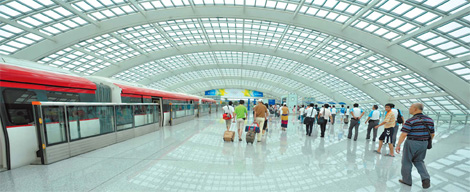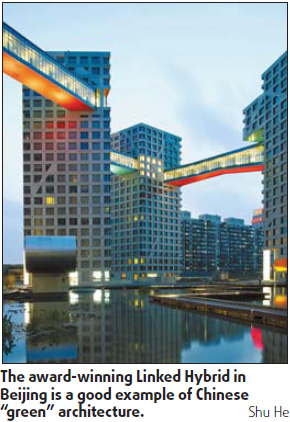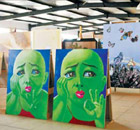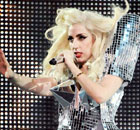Society
Building green a trend in China
By Marcus Schulz (China Daily)
Updated: 2009-12-30 08:33
 |
Large Medium Small |
The latest trend in building architecture in China is being driven more by the urgency of sustainability than by the desire for sublimity. Marcus Schulz reports
When the Olympics began in 2008, the curtain opened on many new architectural wonders in Beijing. Now, architects continue to bring innovation to China's stage by designing environmentally sustainable buildings.
 Beijing International Airport's Terminal Three is one of the architectural wonders of the capital city. Environmental concerns have become one of the priorities for Chinese designers. [Jiang Shenglian] |
Building green is becoming "trendy" in China, according to William Wong, associate director at the Hong Kong office of Arup, a global firm of independent designers, engineers and consultants that helped build the Bird's Nest, the Water Cube, Beijing International Airport's Terminal Three and the new CCTV tower.
"A few years ago, sustainable design was not quite focused and was not seriously considered in most developments," Wong says. "However, development in China is so quick that all levels of government, designers, and even the general public are becoming more aware of environmental issues and how bad the consequences could be due to ignorance of sustainable design."

Environmental concerns are no longer being overlooked by many developers, who have begun to take advantage of the politically correct, socially responsible image that being "green" provides, especially to attract multinational tenants. To prove their buildings are environmentally friendly, design professionals are beginning to adopt standards from the United States for "green" buildings, such as Leadership in Energy and Environmental Design (LEED) certification, an internationally recognized rating system designed by the US Green Building Council. LEED certification is meant to verify that buildings are energy and water efficient, have low CO2 emissions, and utilize local resources that use smaller amounts of energy to create and transport.
Having just completed the Linked Hybrid in Beijing, Steven Holl Architects has established itself among the top of this ground-breaking pack. Their eight-tower structure, attached by floating walkways, received this year's award by the International Council on Tall Buildings and Urban Habitat for the best new tall building in "Asia and Australasia" and was also designed to qualify for a LEED Gold certification, the second-highest LEED rating obtainable.
The Linked Hybrid has one of the largest geothermal cooling and heating systems in the world, exemplifying energy efficiency in new Chinese developments. With the geothermal system, water pipes running through the apartments' floors flow 100 m below the basement in 660 wells, cooling the water in summer and heating it in the winter. The buildings thus maintain a natural temperature between 16 and 21 C without electric air conditioners or water boilers.
The buildings also recycle all of their "gray" water by filtering used water from sinks and bathtubs and reusing it to flush toilets, irrigate roof gardens and fill the structure's outdoor ponds. This reduces water use by more than 40 percent.
However, being energy efficient is not the only aspect to becoming LEED certified, says Li Hu, the partner of Steven Holl Architects and director of projects in China. The production of building materials, managing construction sites to avoid pollution and dealing with construction waste also count when earning points for certification.
"LEED is a rating system of comprehensive factors, not only limited to energy issues," Li says. "It's a process, beginning with where the material comes from, how it's being made, how it's done and how you monitor the indoor quality."
Steven Holl Architects is currently working on two other buildings in China that aim for LEED certification, the Raffles City in Chengdu, Sichuan province, designed for a Gold rating, and the Shenzhen Vanke Center, in Guangdong province, which is pursuing a LEED Platinum certification, the highest rating by the US Green Building Council.
Standing on eight legs, the Vanke Center contains a hotel, apartments, office space and the China Vanke Company headquarters. Underneath the floating, horizontal structure and out of reach of the tropical Shenzhen sun lies a free public park, and ponds filled with recycled water, much like the Linked Hybrid.
The design for the Vanke Headquarters takes care to use renewable and recyclable materials. All the doors, floors and furniture are made from bamboo, which is easily available in the area and quickly renewable, and the carpets throughout the building are made from completely recycled material.
Special windows are designed to keep the building cool by blocking solar heat while still allowing plenty of sunlight, lowering the cost of air conditioning. In addition, the Vanke Headquarters' roof is covered by solar panels, which will provide up to 15 percent of the office's electricity. And, in preparation for the future, the building provides electric car parking and charging stations.
"I think we design for the future; we cannot design for the past," Li says. "A good building always provides opportunities for the future."
China already has many LEED certified buildings and more than 100 under construction seeking approval, yet none has received the prestigious Platinum award. However, the Vanke Center, which is scheduled to be finished by 2010, may not be the first in China to achieve LEED Platinum certification.
Beijing Parkview Green, designed by Integrated Design Associates (IDA), is also aiming to be certified LEED Platinum. With plans to finish construction this year, it may beat the Vanke Center to the punch.
"Competition is good," says Winston Shu, the founder and director of IDA. "And it's good for China to have two platinum projects, if not more."
Beijing Parkview Green, a group of four towers including a hotel, a shopping center and a commercial hub, is completely encased in a transparent "envelope" that protects the buildings from outside weather. The casing has a ventilation system to release hot air in the summer and replace it with cooler air from the ground, and during the winter it acts as a greenhouse to keep warm air around the buildings.
Parkview Green is the first building in Beijing to make use of this "microclimate" with the purpose of minimizing energy consumption. A landmark project in environmentally sustainable design, Shu says the building was only possible because of the developers', architects' and engineers' ambition to benefit the community.
"Architecturally its distinctive form is generated by environmental concerns, not a form created willfully like so many other signature buildings in Beijing," Shu says. "The call for an environmentally sustainable design comes from our collective motivation to create a building that is a legacy for future generations."







